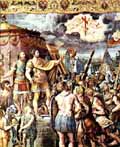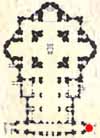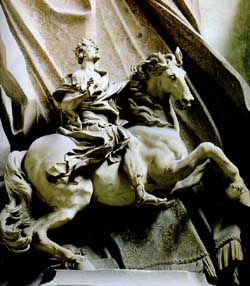| Grottoes
Vatican City Colonnade Saints Floorplan #2 |
| Altars
Monuments The History |
|
Related Items
|
 |
From: 'St. Peter's
Basilica - A Virtual Tour' by Our Sunday Visitor
The two ends of the portico open toward two vestibules uniting it with
the corridors of the colonnade. The one on the right, which provides access
to the Vatican Palace, is the site of the equestrian statue of Constantine,
commissioned to Bernini in 1654 by Innocent X but only completed in 1670,
under the papacy of Clement X, who had it placed at the feet of the Royal
Staircase.
The emperor on a galloping horse is gazing skyward, astonished by the apparition of the cross. Behind the group is a large stucco drapery, imitating damask interwoven with gold, being fluttered by the wind, that adds to the effect of the impetuous movement of the rider.
The impetuous dynamic effect of the statue of Constantine, by Bernini, is accentuated by a large sheet of stucco imitating a damask fabric woven with gold thread. As a result of the diagonal movement of the large folds moved by the wind, it acts like a background. This is a scenic presentation, like a sudden passage on a stage, but which realistically depicts the rush into the battle and the gratified amazement of the leader, certain of victory.
From 'Seminarian's
Guide'
On the right is the equestrian statue of Constantine (Bernini in 1670,
considered a masterpiece). He is rearing back on his horse, startled by
the sign in heaven that he saw, the Cross together with the Greek words
meaning, "In this sign you shall conquer!" These are the two "sentinels"
(the secular defense) of the Church.
From: Guide to St Peter's Basilica, © 2003, Libreria Editrice Vaticana
The work of art was inaugurated on 30th October 1670 by Clement X Altieri,
who wanted it at the foot of the Scala Regia.
The astonished Emperor, riding his horse, looks high at the appearance of the cross. Behind the group, an alive drapery in stucco similar to brocade full of gold emphasizes the impetuous movement of the horse. Many polemics have arisen for the unbalanced and unnatural position of the horse, and disputes for the errors in proportions. Through this equestrian group, Bernini expresses his pictorial conception of sculpture and reaffirms his stylistic originality, keeping the distance from theorized the ideal beauty.


